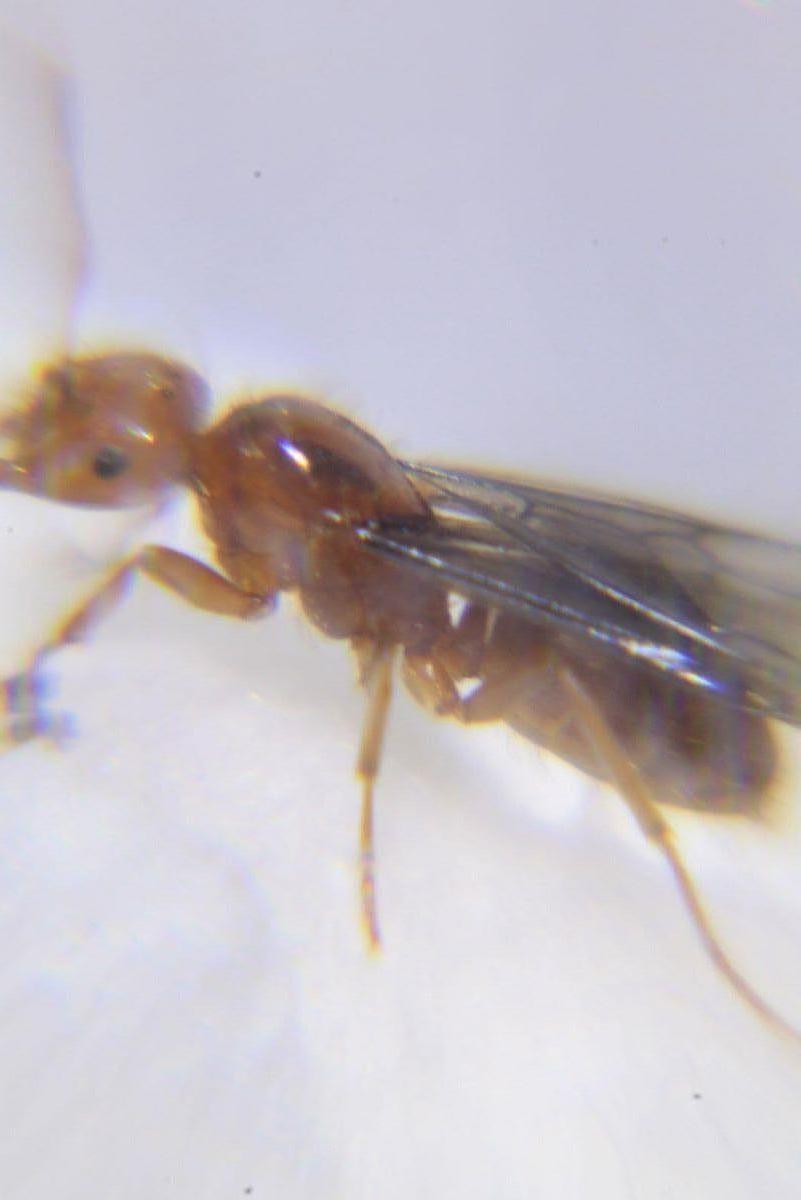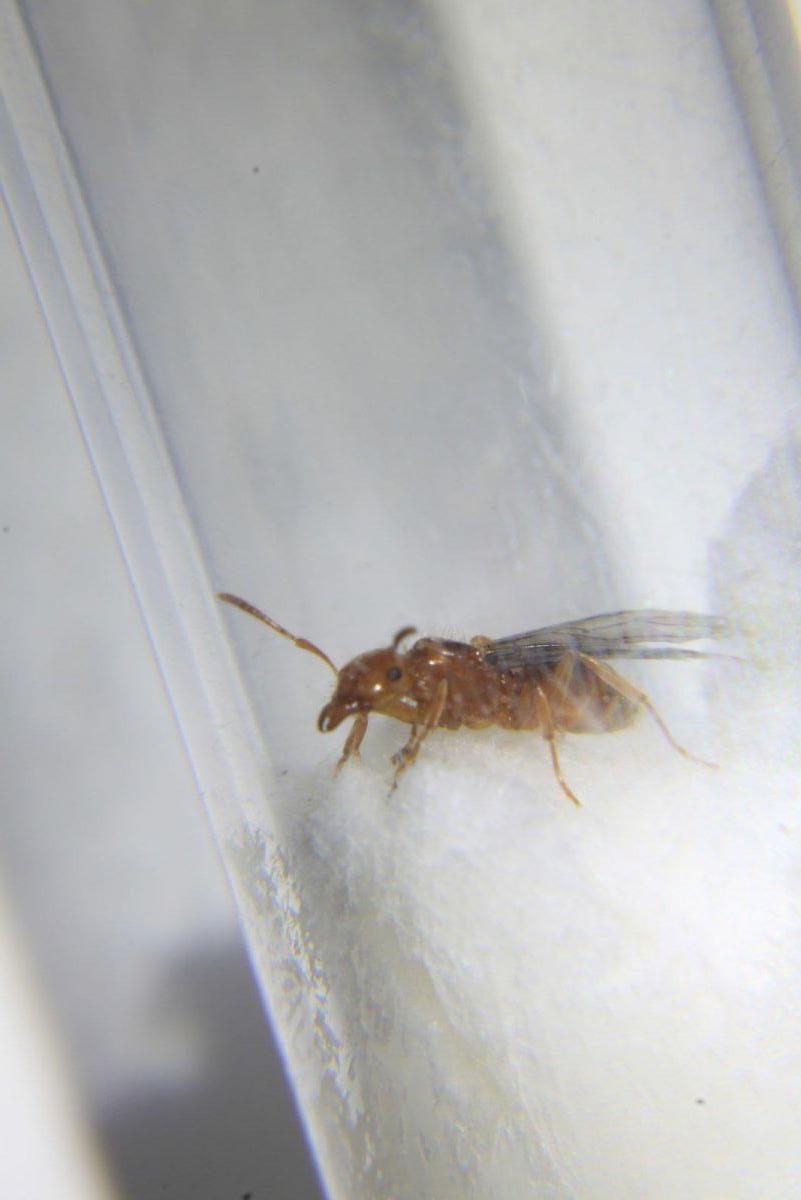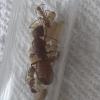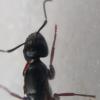That's right, this is a Camponotus worker - likely a large media or a small major. Tentative ID would be Camponotus pennsylvanicus, though with this kind of image quality I'd say that's not definite.
Edited by Miles, June 13 2018 - 2:41 PM.

That's right, this is a Camponotus worker - likely a large media or a small major. Tentative ID would be Camponotus pennsylvanicus, though with this kind of image quality I'd say that's not definite.
Edited by Miles, June 13 2018 - 2:41 PM.
That's right, this is a Camponotus worker - likely a large media or a small major. Tentative ID would be Camponotus pennsylvanicus, though with this kind of image quality I'd say that's not definite.
I agree, you beat me to it!
It's been cool or dry the last week or so, so not much has happened in the way of flights. Though people have seen some Tetramorium and Nylanderia. I thought I saw a C. pennsylvanicus dealate, we ran out to check and it ducked away, however assuming it was, guessing it's a fluke. In the next few days supposed to get much warmer, though still dry so I'm still curious to see if any flights start this weekend.
So far I have 3 surviving C pennsylvanicus queens and each have a clutch of 5-6 eggs. It’s been nearly a month so I’d expect them to begin to eclose in another 4 weeks.
My C. americanus eggs from about 3.5 weeks ago are still small but more elongated now, can't tell if they hatched as still appear to be yellow/orange in color. I *guess* they could be infertile, though that would mean all four were duds. My C. nearticus brood are a bit farther a long as look like they are at the larval stage, however being a much smaller species, that doesn't surprise me that they'd develop a bit faster. When I found a wild colony of C. americanus a few years ago that were in their founding chamber in early April, and there was 5 or 6 nanitics and a tiny pile of brood, so I don't think they grow super fast initially.
I haven't been heating mine, so they've been at upper-70Fs to low 80Fs in temperature, probably not helping. From what I've read, without heat it can take 2-3 months for them to go from egg to worker.
BTW NWS just tweeted this, if it's dry Sat/Sun, I predict Mon could be a very large Camponotus flight:
@NWSBoston
[Record Heat/Humidity Possible Monday] Potential for high temperatures to reach well into the 90s on Monday along with excessive humidity. The excessive heat/humidity looks short lived, but the potential for heat index values of 100+ exists Monday afternoon.
Edited by noebl1, June 14 2018 - 7:59 AM.
My C. americanus eggs from about 3.5 weeks ago are still small but more elongated now, can't tell if they hatched as still appear to be yellow/orange in color. I *guess* they could be infertile, though that would mean all four were duds. My C. nearticus brood are a bit farther a long as look like they are at the larval stage, however being a much smaller species, that doesn't surprise me that they'd develop a bit faster. When I found a wild colony of C. americanus a few years ago that were in their founding chamber in early April, and there was 5 or 6 nanitics and a tiny pile of brood, so I don't think they grow super fast initially.
I haven't been heating mine, so they've been at upper-70Fs to low 80Fs in temperature, probably not helping. From what I've read, without heat it can take 2-3 months for them to go from egg to worker.
If the brood develop into males then your queen is most likely infertile. In my experience C. americanus don't like heating and will avoid heated areas. 70-80 F room temperature is fine.
@ ConcordAntman - Use a reptile heating cable since it can heat multiple nests and you can put it anywhere.
http://www.formicult...achusetts-only/
Youtube. https://www.youtube....Hbsk2xiarcfGTmw
Keeper of...
Aphaenogaster sp
Camponotus americanus, castaneus, chromaiodes, novaeboracensis, pennsylvanicus.
Crematogaster sp
tetramorium immigrans
Formica sp
C pennsylvanicus absolutely is a heat loving species. I personally try keeping my C pennsylvanicus colony at 80-84 F all day and night. Heating a test tube setup you need to be very careful not to heat the cotton ball holding back the water. Doing so may cause leakage or too much condensation possibly kill the brood. This is how I setup my test tubes. 
Edited by akaant, June 14 2018 - 5:10 PM.
http://www.formicult...achusetts-only/
Youtube. https://www.youtube....Hbsk2xiarcfGTmw
Keeper of...
Aphaenogaster sp
Camponotus americanus, castaneus, chromaiodes, novaeboracensis, pennsylvanicus.
Crematogaster sp
tetramorium immigrans
Formica sp
In my experience C. americanus don't like heating and will avoid heated areas. 70-80 F room temperature is fine.
Thanks! This is my first time keeping C. americanus since I found a starter colony a couple years ago (and that was a disaster), so wasn't sure.
I'm in legit colony overload. All my Lasius and Crematogaster Fall caught colonies eclosed the same week.
T. Sessile flying in NH, got to watch alates pour out of a colony in my backyard around noon.
A Camponotus novaeboracensis flight is occurring in Southern Maine! Just snagged myself three. Looks like Tetramorium may fly soon since I noticed they were starting to widen their nest entrances and a lot of frenetic activity.
Haven't seen anything here at all yet, been watching. Boy does Sunday, Monday if not Tuesday look primed now... If the next couple of days there isn't the big Camponotus flight, I'd be really surprised: https://twitter.com/...082553327243265
Pulling up my records from last year, conditions look very similar. We had a 2 week gap of cooler weather, temperature hit 86F on 6/10 and they started flying and had their big flight. This flight lasted into 6/11 which was 94F, and continued for a couple of days. Was the unofficial kick off for the anting season with Tetramorium and others starting shortly after. Last year was a bad flight year as well, so this year in theory should be better.
Edited by noebl1, June 16 2018 - 4:32 PM.
I went back out to find some T. Sessile queens but found this instead:


I'm not quite sure what she is, still looking into it. Once she settles down I'll try to take some better pics.
(I'm starting to realize taking pictures of queens is just as hard if not harder than finding them, haha)
So for a first timer if and when we get a flight other than walking around looking on sidewalks or under logs what should I look out for? I see a lot of ants but don't find many nests. i do know what it looks like when a nest swarms with alates though have seen that in the past.
So for a first timer if and when we get a flight other than walking around looking on sidewalks or under logs what should I look out for? I see a lot of ants but don't find many nests. i do know what it looks like when a nest swarms with alates though have seen that in the past.
I've rarely seen alates leaving the nest accept for Lasius. Even with all the Camponotus and Temnothorax here, I've never actually seen them leaving a nest! You also don't want them right out of the nest anyways as more than likely unmated.
We've been in a lull the last couple of weeks, so don't let that deter you. It's all about getting out there and looking, especially if warm and humid. I often grab a handful of test tubes and just got out walking, whether at work or at home. Some species are much easier than others as well. For example if we have a large flight of Camponotus, they will be easy to spot by those in rural/wood areas as they will be all over the place (and they are very large.) Many species it's matter a luck where conditions are right, and you happen to be walking along the grass, sidewalk or driveway and you see them waddling along. Many people use black lights at night to help with night flying species. Just year this I got my first blacklight, and haven't used it yet as conditions haven't been so good here. However based on what I have seen the past where species like Temnothorax and Lasius alienus were attracted to CFL and deck lighting, I suspect they would be easy to catch on a white sheet with a black light. Access to a swimming pool is another classic one as many species, especially Tetramorium tend to land in pools. After flights I often flip over boards, pieces of wood, rocks, etc and look for queens that went for an easy place to hide before they dig founding chambers.
This time of year I usually try to go out a few times a day to walk around the property, up and down the driveway (it's really long and wooded both sides), and go out after dark with a flashlight. At work I also try to take a lap or two around the area to look along side walks. This time of year my neck is permanently bent down as walking so I don't miss anything on the ground.
It reminds me a lot of fishing, right location, right conditions, lot's of patience and a bit of luck. As summer heat comes along, it gets much easier. If there's a hot humid day, especially after rain, the odds are good *something* will be flying. Since 2016 when I got serious about keeping ants, I've seen alates in MA for Aphaenogaster, Brachymyrmex, Camponotus, Crematogaster, Dolichoderus, Formica, Lasius, Myrmecina, Myrmica, Ponera, Prenolepis, Temnothorax, and Tetramorium. I've caught those walking along randomly by accident on a side walk, driveway or on the grass, at night with flashlights, walking across my desk at work, swimming pools, attracted to street lights, etc That's only a portion of the different ant species we have here in MA, so odds are with you if you keep looking, you will catch something ![]()
I went back out to find some T. Sessile queens but found this instead:
I'm not quite sure what she is, still looking into it. Once she settles down I'll try to take some better pics.
(I'm starting to realize taking pictures of queens is just as hard if not harder than finding them, haha)
I went out for the same exact reason and found likely the same Lasius parasitic species. I'm hoping for something tonight.
http://www.formicult...achusetts-only/
Youtube. https://www.youtube....Hbsk2xiarcfGTmw
Keeper of...
Aphaenogaster sp
Camponotus americanus, castaneus, chromaiodes, novaeboracensis, pennsylvanicus.
Crematogaster sp
tetramorium immigrans
Formica sp
I went out for the same exact reason and found likely the same Lasius parasitic species. I'm hoping for something tonight.
After reading up on them I'm definitely not ready to try and raise such a difficult species, however I was able to find a T. Sessile from yesterday hiding under a brick.
Ants & Myrmecology →
General →
Want to connect with other ant keepers in MaineStarted by Naturenut1233 , Mar 29 2024 |
|

|
||
Market Place →
General Market Place →
Ottercl's Ant Shop (Massachusetts)Started by Ottercl , Aug 4 2023 |
|

|
||
Anting →
Ant ID Requests →
Can anyone identify which ant this is?Started by KodexFB , Sep 26 2022 |
|

|
||
Ant Keeping →
General Ant Keeping →
Can anyone identify which ant this is?Started by KodexFB , Sep 26 2022 |
|

|
||
Market Place →
General Market Place →
Looking to buy Queens/Already built colony's in CTStarted by OliverO , Nov 11 2021 |
|

|
0 members, 0 guests, 0 anonymous users